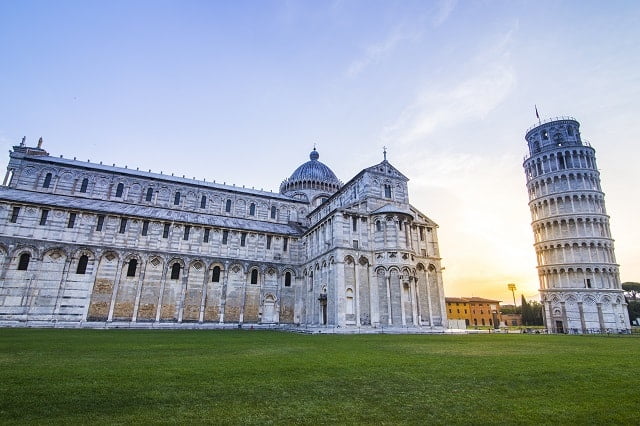Italy is a treasure trove of captivating experiences, from its stunning architecture to its picturesque beaches and delectable cuisine. With its rich history and diverse cultural offerings, Italy has something for every type of traveler. From the iconic landmarks of Rome to the leisurely lifestyle of the “Dolce Vita,” exploring Italian travel is an adventure in itself.
The appeal of Italy as a travel destination lies in its ability to offer a wide range of experiences that cater to all interests. Whether you’re drawn to the historical architecture of ancient ruins, the laid-back charm of coastal towns, or the culinary delights found in every region, Italy has it all. This article will guide you through the ABC’s of Italian travel, providing insight into the unique aspects that make this country a must-visit destination.
From exploring the architectural wonders of Rome, Florence, and Venice to soaking up the sun on the beaches of Amalfi Coast and indulging in authentic Italian cuisine, there’s no shortage of unforgettable experiences awaiting travelers in Italy. As we delve into each aspect of Italian travel, you’ll discover why this Mediterranean gem continues to capture the hearts and imaginations of visitors from around the world.
A is for Architecture
Italy is renowned for its rich history and stunning architecture, making it a must-visit destination for travelers interested in art, culture, and history. Cities like Rome, Florence, and Venice are home to iconic landmarks that showcase the country’s architectural prowess. The Colosseum in Rome, the Duomo in Florence, and St. Mark’s Basilica in Venice are just a few examples of the breathtaking architecture that can be found in Italy.
Italian architecture not only serves as a visual spectacle but also plays a significant role in shaping the country’s culture. From ancient Roman ruins to magnificent Renaissance structures, each architectural style tells a story about Italy’s past and its influence on modern society. The meticulous design and craftsmanship present in Italian buildings reflect the country’s dedication to preserving its historical heritage while embracing innovation.
Visitors to Italy can immerse themselves in the beauty of Italian architecture by taking guided tours of famous landmarks, exploring lesser-known gems off the beaten path, or simply strolling through cobblestone streets lined with historic buildings. The intricate details, ornate facades, and timeless elegance of Italian architecture offer an enriching experience that captures the heart and soul of the country.
| Destination | Iconic Landmark |
|---|---|
| Rome | The Colosseum |
| Florence | The Duomo |
| Venice | St. Mark’s Basilica” |
B is for Beaches
Italy is not only known for its historic architecture and delectable cuisine, but also for its stunning beaches along the Mediterranean coast. From the colorful cliffside towns of the Amalfi Coast to the crystal-clear waters of Sardinia, the Italian coastline offers a diverse range of beach experiences for travelers to enjoy. Here are some must-visit beach destinations in Italy:
- The Amalfi Coast: This UNESCO World Heritage site is famous for its dramatic coastal scenery, pastel-colored villages, and pebble beaches. Visitors can explore charming towns like Positano and Ravello while soaking up the sun on picturesque beaches like Spiaggia Grande.
- Cinque Terre: Known for its rugged coastline and vibrant seaside villages, Cinque Terre is a paradise for hikers and beach lovers alike. Travelers can discover hidden coves and secluded beaches while indulging in freshly caught seafood at waterfront restaurants.
- Sardinia: With its white sandy beaches and turquoise waters, Sardinia is a haven for sun-seekers and water sports enthusiasts. The island boasts world-class resorts, such as Costa Smeralda, as well as unspoiled stretches of shoreline that offer peaceful seclusion.
Italian beach culture goes beyond just beautiful scenery and warm weather. Visitors can also experience traditional coastal activities such as sipping Aperol spritz at beachside bars, enjoying fresh seafood dinners with ocean views, and partaking in water sports like snorkeling and sailing. Whether it’s relaxing on the sands of Sicily or exploring hidden coves in Puglia, Italy’s beaches offer a diverse range of experiences for every type of traveler.
C is for Cuisine
Italian cuisine is celebrated worldwide for its delicious flavors, fresh ingredients, and regional diversity. From the hearty pasta dishes of the north to the seafood specialties of the south, Italian food offers something for every palate. When traveling to Italy, experiencing the local cuisine is an essential part of immersing oneself in the culture and tradition of the country.
Regional Variations
One of the unique aspects of Italian cuisine is its regional variations. Each region in Italy boasts its own set of culinary traditions and specialties, influenced by factors such as geography, climate, and historical influences.
For example, while northern Italy is known for its risottos and rich, creamy sauces, southern Italy offers an abundance of fresh seafood dishes and olive oil-based recipes. Travelers can explore these regional differences in food by sampling local dishes and visiting markets and restaurants that feature traditional recipes.
Authentic Dining Experiences
To fully appreciate Italian cuisine, travelers should seek out authentic dining experiences that highlight the best of what each region has to offer. From family-owned trattorias to Michelin-starred restaurants, there are countless opportunities to indulge in delicious meals prepared with care and attention to detail. Whether it’s savoring a wood-fired pizza in Naples or enjoying a multi-course meal in Tuscany paired with local wines, dining in Italy is an integral part of the travel experience.
Culinary Tourism
For those who are passionate about cooking and food culture, culinary tourism has become increasingly popular in Italy. Visitors can participate in cooking classes, market tours, wine tastings, and farm-to-table experiences that provide insight into the culinary traditions of the country.
These activities not only offer a hands-on learning experience but also create lasting memories as travelers engage with local chefs and producers while gaining a deeper appreciation for Italian cuisine. Whether it’s learning how to make homemade pasta or discovering the art of wine pairing, culinary tourism allows travelers to take a piece of Italian gastronomy home with them.
D is for Dolce Vita
Italy is famous for its “dolce vita” or “sweet life” lifestyle, which prioritizes leisure, relaxation, and enjoyment. Embracing the dolce vita while traveling in Italy can lead to unforgettable experiences and a deeper appreciation for the country’s culture and lifestyle.
When visiting Italy, it’s important to take the time to slow down and savor the simple pleasures of life. From sipping espresso at a sidewalk café to enjoying leisurely strolls through charming piazzas, there are many opportunities to embrace the dolce vita while traveling. Consider creating a travel itinerary that allows for plenty of unstructured time to simply soak up the atmosphere and ambiance of Italian cities and towns.
The concept of the dolce vita also extends to indulging in local culinary delights, such as gelato, pastries, and fine wines. In addition to enjoying sumptuous meals at traditional trattorias and osterias, travelers should also seek out local markets to sample fresh produce and artisanal goods. By immersing yourself in the food culture of Italy, you can gain a greater understanding of how central dining is to the Italian way of life.
- Embrace leisurely activities such as people-watching in picturesque squares or gardens.
- Savor the flavors of Italian cuisine by sampling regional specialties at local markets.
- Seek out authentic experiences that allow for relaxation and reflection on the joys of everyday life.
E is for Entertainment
Italy is well-known for its vibrant entertainment scene, offering a diverse array of cultural experiences for travelers to enjoy. One of the most iconic forms of entertainment in Italy is opera, with the country being home to world-renowned opera houses such as Teatro alla Scala in Milan and Teatro di San Carlo in Naples. Attending a live opera performance is not only a captivating experience but also provides insight into the rich cultural heritage of Italy.
In addition to opera, Italy hosts numerous festivals throughout the year, celebrating everything from music and film to food and wine. These festivals showcase Italian artistry and traditions, providing visitors with an immersive cultural experience. For example, the Venice Film Festival is one of the oldest film festivals in the world and attracts international filmmakers and celebrities, adding an element of glamour to Italian entertainment.
Furthermore, Italy has a thriving performing arts scene with theaters and concert halls featuring a wide range of productions including ballet, theater performances, classical concerts, and contemporary dance shows. The arts play a significant role in Italian society, reflecting the country’s history, creativity, and passion for expression. Travelers can enrich their Italian experience by immersing themselves in these captivating forms of entertainment while exploring the country’s diverse regions.
| Form of Entertainment | Example |
|---|---|
| Opera | Teatro alla Scala in Milan |
| Festivals | Venice Film Festival |
| Performing Arts | Theaters and concert halls featuring various productions |
F is for Fashion
Italy has long been synonymous with fashion, and the country’s influence on the industry cannot be understated. From iconic fashion houses to luxury shopping districts, Italian fashion plays a significant role in shaping global trends and style. When exploring the ABC’s of Italian travel, embracing the world of Italian fashion is an essential part of the experience.
Iconic Fashion Houses
Italian fashion is home to some of the most renowned and influential fashion houses in the world. From Gucci and Prada to Versace and Dolce & Gabbana, these brands have become synonymous with luxury, quality, and trendsetting design. Travelers can immerse themselves in the world of Italian fashion by visiting flagship stores, exploring museum exhibitions dedicated to iconic designers, or even attending runway shows during Fashion Week.
Luxury Shopping Districts
For those who love indulging in high-end shopping experiences, Italy offers a wealth of luxury districts where travelers can peruse designer boutiques and flagship stores. Milan’s Quadrilatero della Moda (Fashion Quadrilateral) is famous for its concentration of high-fashion stores, while Rome’s Via dei Condotti is lined with luxurious storefronts showcasing the latest designer collections.
Whether window-shopping or splurging on a special piece, strolling through these districts provides insight into Italy’s enduring influence on global fashion.
The Role of Fashion in Italian Culture
Fashion plays a central role in Italian culture, from everyday street style to formal occasions. The emphasis on personal style and sartorial elegance is evident in Italy’s vibrant cities and picturesque towns alike. As travelers immerse themselves in the local culture, they’ll notice that fashion is not just about clothing-it’s a form of self-expression deeply woven into the fabric of Italian life.
Embracing F for Fashion means embracing Italy’s distinct sense of style and luxury. By exploring iconic fashion houses, indulging in luxury shopping experiences, and understanding the role of fashion in Italian culture, travelers can gain a deeper appreciation for this essential aspect of Italian travel. Whether it’s discovering the latest trends or immersing oneself in timeless elegance, Italy offers a unique and enriching experience for fashion enthusiasts around the world.
Conclusion
In conclusion, the ABC’s of Italian travel provide a comprehensive guide to experiencing the rich cultural heritage and diverse experiences that Italy has to offer. From the stunning architecture of cities like Rome, Florence, and Venice to the picturesque beaches of the Amalfi Coast and Cinque Terre, Italy’s beauty and history are truly one-of-a-kind.
The world-renowned Italian cuisine, emphasis on “the sweet life” (dolce vita), vibrant entertainment scene, and influence on the fashion industry all contribute to the unique allure of traveling in Italy.
As travelers explore each aspect of the ABC’s of Italian travel, they are sure to encounter enriching experiences that will create lasting memories. Whether it’s savoring authentic Italian dishes, relaxing on a sun-drenched beach, or immersing oneself in the vibrant performing arts scene, embracing the unique aspects of Italian travel is essential for fully appreciating everything this beautiful country has to offer.
By delving into these different facets of Italian culture and lifestyle, travelers can gain a deeper understanding and appreciation for what makes Italy such a beloved and captivating destination.
Ultimately, embracing the ABC’s of Italian travel allows for a truly immersive and fulfilling experience in one of the most culturally-rich countries in the world. By seeking out architectural wonders, indulging in delicious cuisine, leisurely enjoying “the sweet life,” taking in vibrant entertainment, and exploring high-quality fashion influences, travelers can make their journey through Italy an unforgettable one.
It is this embrace of diversity and richness that makes Italian travels so special-encouraging all who visit to soak up every moment and opportunity for discovery and enjoyment.
Frequently Asked Questions
What is the best way to learn Italian for travelers?
The best way to learn Italian for travelers is to immerse yourself in the language as much as possible. This can include taking a beginner’s Italian language course, practicing with language learning apps, and making an effort to speak with locals while in Italy.
Additionally, listening to Italian music, watching Italian movies or TV shows, and reading books or newspapers in Italian can also help improve language skills.
Is it difficult to learn Italian?
Learning Italian can be challenging, but it ultimately depends on the individual’s willingness to put in the time and effort to learn the language. Italian grammar and verb conjugations may initially seem daunting, but with consistent practice and exposure to the language, many people find that they can make significant progress in a reasonably short period of time.
Is it hard to travel to Italy without speaking Italian?
It is not necessarily hard to travel to Italy without speaking Italian, especially if you visit larger cities or popular tourist destinations where English is commonly spoken. However, knowing some basic Italian phrases can greatly enhance the overall travel experience by allowing you to communicate with locals more effectively and navigate day-to-day interactions such as ordering food, asking for directions, or making small talk.
Regardless of your fluency level in Italian, a positive attitude and willingness to engage with the local culture are essential for any traveler visiting Italy.

I’m a passionate traveler, writer, and Italophile. My fascination with Italy’s history, art, and culture has led me on countless adventures across the Italian landscape. Through “I Live Italy,” I share my love for this extraordinary country and aims to inspire others to explore its boundless beauty.




